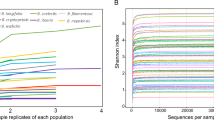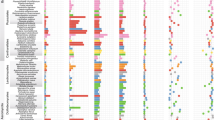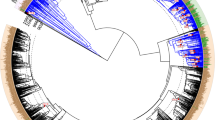Abstract
MONOTROPES (Monotropoideae, Ericaceae) are achlorophyllous, epiparasitic plants that receive all of their fixed carbon from green plants through a common ectomycorrhizal association rather than by a direct parasitic connection (Fig. 1)1,2. Using molecular identification methods we show that some monotropes are highly specific in their fungal associations and at least one species, Pterosporo andromedea is specialized on a single species group within the genus Rhizopogon. Phylogenetic analysis of the Monotropoideae shows that specialization has been derived through narrowing of fungal associations within the lineage containing P. andromedea. High specificity is contrary to past predictions for the Monotropoideae and for plant communities in general, raising many questions about the roles of mycorrhizal specificity in ecosystem function.
This is a preview of subscription content, access via your institution
Access options
Subscribe to this journal
Receive 51 print issues and online access
$199.00 per year
only $3.90 per issue
Buy this article
- Purchase on Springer Link
- Instant access to full article PDF
Prices may be subject to local taxes which are calculated during checkout
Similar content being viewed by others
References
Björkman, E. Physiol. Plt. 13, 308–327 (1960).
Leake, J. R. New Phytol. 127, 171–216 (1994).
Read, D. J. Experientia 47, 376–391 (1991).
Malloch, D. W., Pirozynski, K. A. & Raven, P. H. Proc. natn. Acad. Sci. U.S.A. 77, 2113–2118 (1980).
Borowicz, V. A. & Juliano, S. A. Evol. Ecol. 5, 385–392 (1991).
Molina, R., Massicotte, H. & Trappe, J. M. in Mycorrhizal Functioning; An Integrative Plant-Fungal Process (ed. Allen, M. F.) 357–423 (Chapman and Hall, New York, 1992).
Van der Plank, J. E. Genetic and Molecular Basis of Plant Pathogenesis (Springer, New York, 1978).
Castellano, M. A. & Trappe, J. M. Mycologia 77, 499–502 (1985).
Bruns, T. D., Fogel, R., White, T. J. & Palmer, J. D. Nature 339, 140–142 (1989).
Bruns, T. D. & Szaro, T. M. Molec. Biol. Evol. 9, 836–855 (1992).
Miller, S. I., Koo, C. D. & Molina, R. Can. J. Bot. 69, 516–532 (1991).
Bruns, T. D. Pl. Soil 170, 63–73 (1995).
Natarajan, K., Mohan, V. & Ingelby, K. Soil Biol. Biochem. 24, 279–280 (1992).
Danielson, R. M. Can. J. Bot. 62, 932–939 (1984).
Thompson, J. N. The Coevolutionary Process 1–376 (University of Chicago Press, 1994).
Price, P. W. Evolutionary Biology of Parasites 1–237 (Princeton University Press, Princeton, NJ, 1980).
Cullings, K. J. Evol. Biol. 7, 501–516 (1992).
Janzen, D. H. Evolution 34, 611–612 (1980).
Molina, R. & Trappe, J. M. New Phytol. 126, 653–675 (1994).
Molina, R. & Trappe, J. M. Forest Sci. 28, 423–458 (1982).
Finlay, R. D. New Phytol. 112, 185–192 (1989).
Bruns, T. D. & Gardes, M. Molec. Ecol. 2, 233–242 (1993).
Gardes, M. & Bruns, T. D. Molec. Ecol. 2, 113–118 (1993).
Baura, G., Szaro, T. M. & Bruns, T. B. Mycologia 84, 592–597 (1992).
Vilgalys, R. & Sun, B. L. Proc. natn. Acad. Sci. U.S.A. 91, 4599–4603 (1994).
Kasuga, T., Woods, C., Woodward, S. & Mitchelson, K. Curr. Genet. 24, 433–436 (1993).
Felsenstein, J. PHILIP (Computer program, Univ. Washington, Seattle, 1995).
Swofford, D. L. PAUP (Computer program, Smithsonian Institution, Washington, DC, 1993).
Molina, R. & Trappe, J. M. New Phytol. 90, 495–509 (1982).
Author information
Authors and Affiliations
Rights and permissions
About this article
Cite this article
Cullings, K., Szaro, T. & Bruns, T. Evolution of extreme specialization within a lineage of ectomycorrhizal epiparasites. Nature 379, 63–66 (1996). https://doi.org/10.1038/379063a0
Received:
Accepted:
Issue Date:
DOI: https://doi.org/10.1038/379063a0
This article is cited by
-
Communities of mycorrhizal fungi in different trophic types of Asiatic Pyrola japonica sensu lato (Ericaceae)
Journal of Plant Research (2020)
-
Studies on Ectomycorrhiza: An Appraisal
The Botanical Review (2018)
-
Molecular characterizations of somatic hybrids developed between Pleurotus florida and Lentinus squarrosulus through inter-simple sequence repeat markers and sequencing of ribosomal RNA-ITS gene
3 Biotech (2017)
-
Restriction fragment length polymorphism and sequence analysis of rRNA-ITS region of somatic hybrids produced between Pleurotus florida and Lentinula edodes
Annals of Microbiology (2016)
-
Partial mycoheterotrophy in Pyroleae: nitrogen and carbon stable isotope signatures during development from seedling to adult
Oecologia (2015)
Comments
By submitting a comment you agree to abide by our Terms and Community Guidelines. If you find something abusive or that does not comply with our terms or guidelines please flag it as inappropriate.



